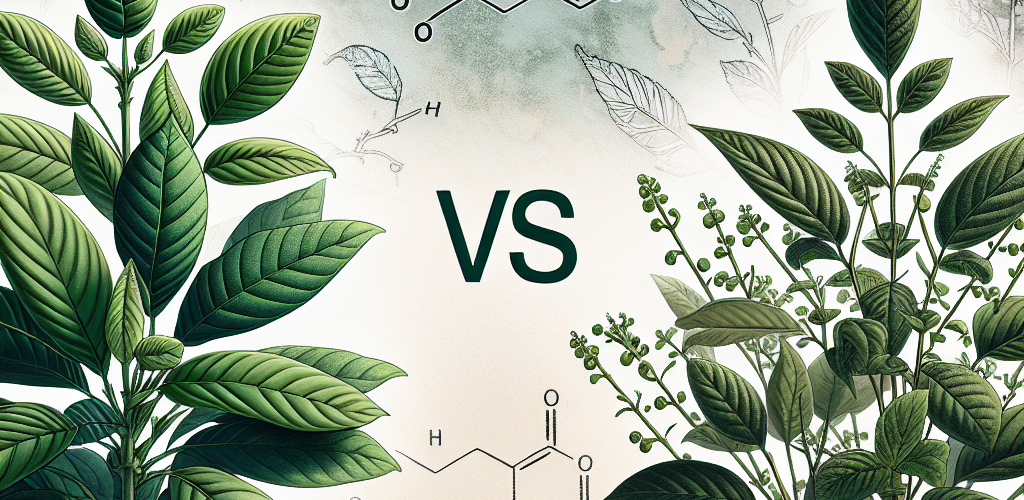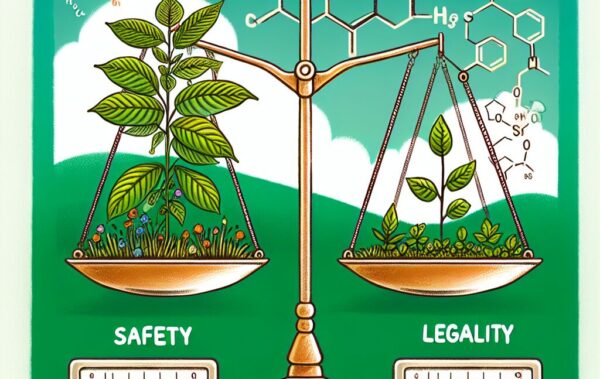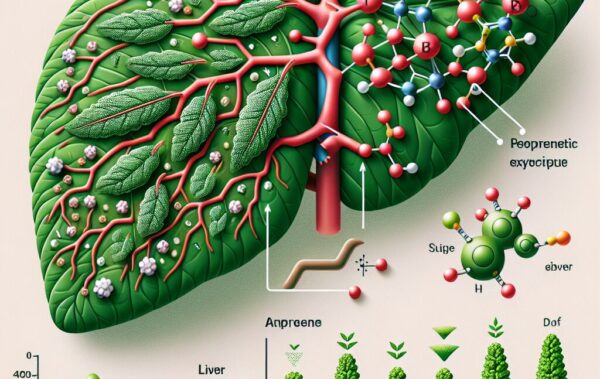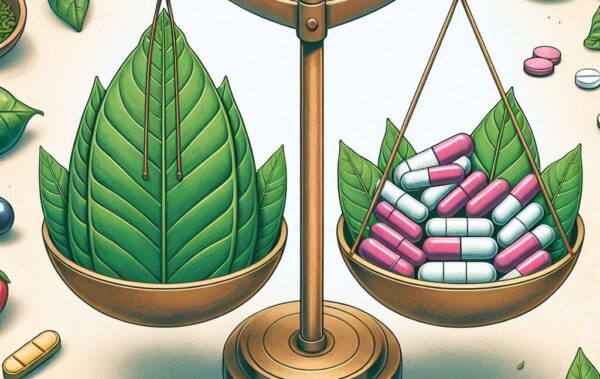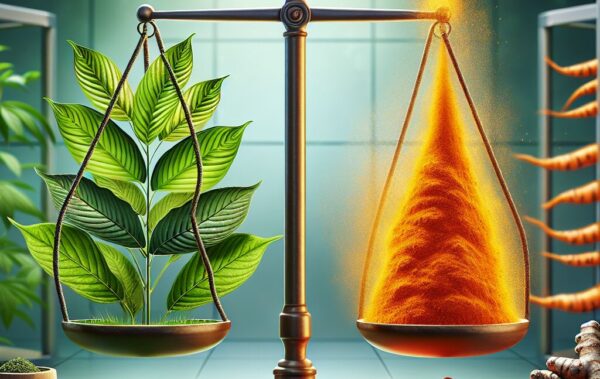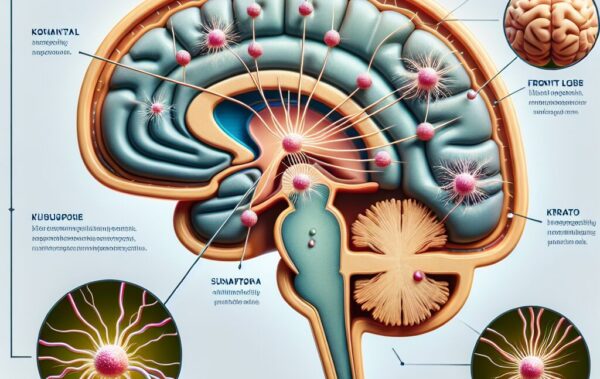- Botanical background of kratom and yerba mate
- Mechanisms of action for alertness
- Efficacy of kratom versus yerba mate in promoting alertness
- Safety profiles and potential side effects
- User experiences and recommendations
Kratom, scientifically known as Mitragyna speciosa, is an evergreen tree from the coffee family native to Southeast Asia. Its leaves have been used for centuries by indigenous people for their psychoactive properties. They contain mitragynine and 7-hydroxymitragynine, which are the primary active compounds responsible for kratom’s stimulating and sedative effects. Traditionally, the leaves are chewed fresh, or they are dried and crushed into a powder that can be swallowed directly or brewed into a tea. For convenience, kratom is also available in various other forms such as capsules, shots, and tinctures.
On the other hand, Yerba Mate, or Ilex paraguariensis, is a species of the holly family found primarily in South America. It is renowned for its energizing properties and is often consumed as a beverage called mate, a cultural icon in countries like Argentina, Uruguay, Paraguay, and Southern Brazil. Similar to tea, the preparation of yerba mate involves steeping dried leaves in hot water. The resulting herbal drink offers an energy boost attributed to its caffeine content, alongside theobromine and theophylline—natural compounds also found in tea, coffee, and chocolate.
Both kratom and Yerba Mate are known for their effects on alertness, though they are derived from different botanical backgrounds. Kratom’s interaction with opioid receptors in the brain can produce stimulation at low doses, leading to increased energy and alertness. Meanwhile, Yerba Mate is rich in xanthines, such as caffeine, which are well-established stimulants that act on the central nervous system.
Consumers looking for an energy boost may turn to these herbal drinks as alternatives to conventional caffeine sources like coffee. The appeal of kratom and Yerba Mate lies in their distinct cultural backgrounds and their varying mechanisms of action. While Yerba Mate provides a familiar caffeine-induced alertness, the physically stimulating effects of kratom at lower doses provide a different experience that is less common in the Western world.
As these herbal remedies gain popularity, the demand for easy and accessible forms of consumption has risen. Marketplaces focusing on natural botanicals offer a variety of kratom and Yerba Mate products to suit individual preferences. Some users may prefer the convenience of online shopping to explore the diverse offerings of these energizing plants. Whether one is an aficionado of the traditional kratom leaf or inclined towards a tantalizing cup of Yerba Mate, these botanicals cater to a spectrum of preferences for achieving that much-needed energy boost and alertness.
Mechanisms of action for alertness
When considering the mechanisms of action for alertness provided by kratom and yerba mate, it is important to recognize the diverse interaction each has within the human body, especially in terms of stimulating brain activity and enhancing one’s state of wakefulness.
Kratom’s primary active alkaloids, mitragynine and 7-hydroxymitragynine, exert a notable impact on the brain’s opioid receptors. While this may conjure associations with traditional opioids, kratom’s mechanism is distinct, especially at lower dosages, where it typically stimulates receptor sites rather than overpowering them like conventional opioids. This stimulation can lead to an increase in energy levels, perceived well-being, and heightened alertness. The lower doses of kratom encourage the release of neurotransmitters that play a role in increasing alertness and energy, providing a mental clarity that many users appreciate.
On the flip side, yerba mate takes a more direct route to stimulation through its caffeine content which works by blocking adenosine receptors in the brain. Adenosine is a neurotransmitter that promotes relaxation and sleepiness. As yerba mate hinders adenosine’s activity, the opposite effects materialize – increased alertness and reduced fatigue. The presence of other xanthines like theobromine and theophylline in yerba mate complement caffeine’s effects by dilating blood vessels, improving muscle contraction, and enhancing overall heart function, which can further increase alertness and provide a sustaining energy boost.
Distinguishing itself as an herbal drink, yerba mate is often enjoyed for the complementary benefits associated with its polyphenol antioxidants, saponins, and amino acids that contribute to mental energy, focus, and alertness, beyond the singular effects of caffeine. The orchestration of these compounds positions yerba mate as a multifaceted stimulant, admired not only for its energy-boosting caffeine but also for a broader spectrum of health benefits that can contribute to a state of wakefulness.
Individuals exploring kratom as an alternative means for achieving alertness might experiment with different strains, such as White Vein varieties, which are often reputed for their invigorating properties. Meanwhile, yerba mate enthusiasts may opt for a ritualistic preparation of the drink, which allows for control over the strength and composition of the infusion to enhance energy and alertness throughout the day.
It is intriguing to analyze how two botanicals, stemming from separate geographical and cultural origins, can both converge on the common pursuit of enhancing alertness and providing an energy boost. As individuals seek natural alternatives to traditional stimulants, kratom and yerba mate stand out as two herbal drinks with unique but effective approaches to achieving heightened alertness and mental clarity. As part of an approach to a more natural lifestyle, or simply in search of a different kind of energy boost, consumers find value in the effects offered by these compelling botanicals.
Efficacy of kratom versus yerba mate in promoting alertness
Comparing the efficacy of kratom versus yerba mate in promoting alertness brings us to the crux of what consumers interested in these herbal remedies really want to know: which one is going to give you that necessary pep in your step? Especially for those looking to steer clear of the jitters and crash often accompanying a strong cup of coffee, the subtle nuances of these stimulants can be a game-changer.
Kratom, particularly the Green Vein and White Vein strains, is lauded for its ability to foster an alert yet calm cognitive state. Consumers often report that kratom provides an energy boost that supports mental clarity without the overstimulation that can occur with caffeine-heavy beverages. Moreover, the unique alkaloid combination in kratom is noted for its potential to enhance cognitive functions that contribute to a state of wakefulness and improved attention spans. This balance of alertness and mental clarity is particularly attractive for those who need to remain focused for long periods, such as students or professionals facing demanding tasks.
Yerba mate, in contrast, is traditionally seen as a social drink, yet its virtue for enhancing alertness cannot be understated. It maintains steady notoriety for its invigorating effects that are largely attributed to its caffeine content, which, compared to coffee, typically delivers a smoother increase in energy without the sudden onset of restlessness or irritability. Notable too is that yerba mate is rich in nutrients and compounds that offer a sustained energy boost–a trait often missing from conventional caffeinated drinks.
Those who have experienced both kratom and yerba mate tend to describe their energies as quite distinct. While yerba mate might be the go-to for a steady, clean alertness that invites social interaction and enhances mood, kratom’s spectrum of effects at varying doses can offer a more nuanced approach to boosting energy. With kratom, small amounts could make one feel more talkative and energetic, while larger doses might induce sedating effects, which is vastly different from the consistent stimulant effect of yerba mate.
Let’s look at some key points:
- Kratom may offer a dual benefit of promoting alertness while providing the calm needed for focused activities.
- Yerba mate typically delivers a smoother, less intense energy boost than kratom, without the highs and lows that can be associated with other caffeinated drinks.
- Both kratom and yerba mate are considered less likely to cause jitteriness or a ‘crash’ compared to coffee, though individual experiences can vary.
Further complicating direct comparisons is the breadth of kratom products available on the market. From extracts and edibles to powders and teas, the form in which kratom is consumed can also influence its efficacy in promoting alertness. Additionally, the potency of the kratom, often determined by factors like leaf maturity and processing methods, will affect its stimulant capacity.
Yerba mate offers fewer variations aside from the choice between loose-leaf and more commercial, conveniently packaged forms such as tea bags or pre-bottled drinks. Still, customizing the strength and ratio of water to leaves can afford yerba mate consumers control over the intensity of their herbal drink.
In the end, the efficacy of kratom versus yerba mate in promoting alertness depends on personal preference, the sensitivity of the individual to the active compounds in each plant, and the specifics of how they are consumed. Both offer compelling benefits, and through personal experience and experimentation, users can determine the best botanical for their unique needs in achieving that desired energy boost and state of heightened alertness.
Safety profiles and potential side effects
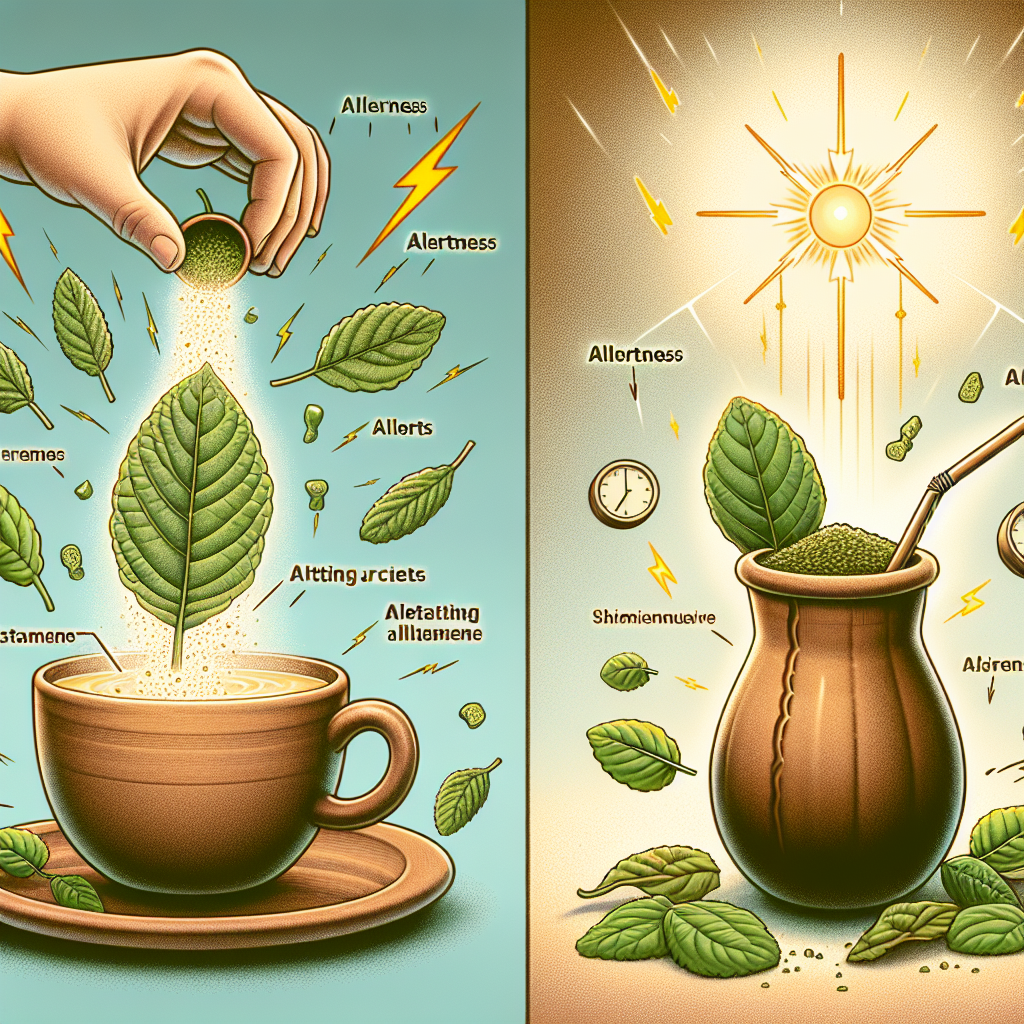 When we delve into the realm of safety profiles and potential side effects concerning kratom and yerba mate, we’re examining a critical aspect of any substance’s use—their implications on health and well-being. Users interested in such herbal remedies for alertness and energy boost owe it to themselves to be informed about the potential risks and side effects associated with these botanicals.
When we delve into the realm of safety profiles and potential side effects concerning kratom and yerba mate, we’re examining a critical aspect of any substance’s use—their implications on health and well-being. Users interested in such herbal remedies for alertness and energy boost owe it to themselves to be informed about the potential risks and side effects associated with these botanicals.
Kratom’s safety profile is complex and has been the subject of much debate within the scientific and regulatory communities. It’s essential to note that kratom acts on opioid receptors, which introduces the potential for dependence and withdrawal in certain individuals, particularly when consumed in large quantities over prolonged periods. Side effects from kratom use can include nausea, constipation, sleep issues, and loss of appetite. In some cases, more severe side effects like liver toxicity, seizure, and psychosis have been reported, though such occurrences are relatively rare and often associated with higher dosages or interactions with other substances.
The legality of kratom varies, with some countries and states considering it a controlled substance, while others permit its sale and use. This legal status can impact the quality control and regulation of kratom products, potentially exposing users to adulterated products or varying potency levels. As such, consumers are encouraged to source kratom from reputable vendors who can provide lab-tested products for quality assurance. For instance, anyone looking for reliable and safe kratom may want to explore kratom capsules, which offer controlled dosages and are convenient for regular use.
Yerba mate, by comparison, is generally considered safe when consumed in moderate amounts. The primary consideration with yerba mate pertains to its caffeine content, which can lead to side effects familiar to those sensitive to other caffeine sources: insomnia, increased heart rate, and restlessness. An important yet often overlooked concern is the link between very high consumption of yerba mate and an increased risk of esophageal cancer. This correlation is primarily observed in South American regions where yerba mate is traditionally consumed at very high temperatures, which is thought to contribute to the risk.
To minimize potential side effects, yerba mate lovers should be mindful of their overall caffeine consumption and opt for cooler drinking temperatures. As with any herbal drink, moderation is key. Those considering yerba mate for an energy boost can experiment with various form factors—loose-leaf, tea bags, or even bottled beverages—to find a balance that delivers the desired alertness without unwanted side effects.
Both kratom and yerba mate have associated side effects, which vary in severity and likelihood. Given this fact, users should be well-informed and approach usage with caution:
- Potential kratom users should be aware of the risk of dependency and other side effects that may arise from heavy use.
- Yerba mate consumers should moderate their intake to avoid excessive caffeine-related side effects and consider lower temperatures to mitigate health risks.
- Just as important is the consideration of legal and regulatory status of kratom in one’s locale, ensuring only pure and quality-controlled kratom is consumed for safety.
Ultimately, individuals who prioritize an herbal drink for achieving alertness and an energy boost must weigh the benefits against the risks, exercising due diligence in terms of sourcing, consuming responsibly, and monitoring their body’s responses. Those with pre-existing health conditions or taking medications should particularly heed caution and consult with healthcare providers before adding kratom or yerba mate to their regimen to avoid contraindications and ensure safe use.
User experiences and recommendations
Now, as we gather insights from user experiences and distill recommendations for choosing between kratom and yerba mate as an herbal drink for alertness and energy boost, it is clear that personal anecdotes often form a significant part of an individual’s decision-making process.
Those who have explored the world of kratom often share stories of its effectiveness in providing a noticeable energy boost, particularly with strains like Maeng Da and other energizing varieties. Users commonly cite their preference for kratom when facing demands that require both mental stamina and a calm, focused mindset. They state that, unlike traditional stimulants, kratom does not lead to a dreaded crash but instead offers a more steady return to baseline energy levels. For those new to kratom, a common suggestion is starting with a lower dose to gauge individual sensitivity and gradually increasing as needed to achieve the desired effect.
Yerba mate aficionados tout the herbal drink as a central part of their daily routine, often highlighting its social and cultural significance in addition to its stimulating properties. They speak to yerba mate’s ability to offer a smooth, sustainable rise in energy without the negative side effects sometimes associated with coffee, such as stomach discomfort or anxiety. The communal nature of the mate drinking ritual is also frequently mentioned, with many appreciating the blend of both a bodily energy boost and a sense of connection fostered through sharing the drink with others.
Given the subjective nature of these experiences, here are a few recommendations to consider when determining which botanical might best serve one’s needs:
– Start with a small dose of kratom and pay attention to your body’s response. Explore various forms, such as powders for homemade tea or pre-measured capsules, to find what works best for you.
– When trying yerba mate for the first time, adjust the strength to your liking and monitor your caffeine tolerance to avoid overconsumption.
– Engage with online communities or forums to gather user testimonies and learn from others’ experiences with kratom and yerba mate.
– Consider the context in which you’ll be consuming these herbal drinks—kratom might be more suitable for solo tasks demanding concentration, whereas yerba mate can be an excellent choice for social gatherings.
– Always source from reputable vendors that offer quality, tested products to ensure safety and efficacy.
Beyond these user-sourced recommendations, the broader wellness and productivity communities often share their findings through blogs, reviews, and research summaries, providing a wealth of information for those interested in herbal alternatives for an energy boost and increased alertness.
In conclusion, suggestions for opting between kratom and yerba mate largely draw from a blend of personal experiences, cultural practices, and individual health considerations. By adopting a mindful approach to consumption and staying informed through user stories and reputable sources, one can navigate the diverse offerings of these botanicals to find an herbal drink that resonates with their lifestyle and fulfills their search for a natural energy boost and heightened alertness.

